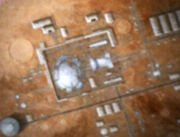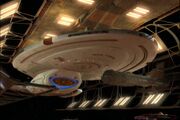No edit summary |
m (→Background information: lnk.fx.) |
||
| Line 48: | Line 48: | ||
The exterior view of the yard in "Relativity" was originally not intended to be shown on screen as the script only called for a shot of the ''Voyager'' in a drydock on its own. Many of the modelers at [[Foundation Imaging]] were fans and took a different view as [[Adam Lebowitz|Adam "Mojo"" Lebowitz]] explained: |
The exterior view of the yard in "Relativity" was originally not intended to be shown on screen as the script only called for a shot of the ''Voyager'' in a drydock on its own. Many of the modelers at [[Foundation Imaging]] were fans and took a different view as [[Adam Lebowitz|Adam "Mojo"" Lebowitz]] explained: |
||
<blockquote>"But when we got the script, we thought, "''Well, we're going to build a drydock and we already have a library of other Federation ships, and making a Mars planet wouldn't be that difficult; it really wouldn't be much more expensive to create a scene of dozens of ships being built.''" So we suggested to the producers, "''Hey, why don't we make a big moment out of this shot and show all the Utopia Planitia shipyards?''" They said, "''OK''", so we eagerly went back into the office and created a temporary scene of what we had in mind with this big, big expanse. We used this big image map of the actual Utopia Planitia area of Mars that was recently surveyed by the Global Planetary Surveyor that NASA sent, and we showed it to [[Dan Curry]] and [[Ronald B. Moore|Ron Moore]] and [[Peter Lauritson]] and they liked it. Then they said, "''While you're at it, why don't you add this scene and add some space stations back there?''", and we said, "''No problem.''" And of course the scene wound up turning into 10 times more work than we originally planned for, but we just wanted to do it. We wanted to see that on the air." ({{STTM|1|6}}, p. 50)</blockquote> |
<blockquote>"But when we got the script, we thought, "''Well, we're going to build a drydock and we already have a library of other Federation ships, and making a Mars planet wouldn't be that difficult; it really wouldn't be much more expensive to create a scene of dozens of ships being built.''" So we suggested to the producers, "''Hey, why don't we make a big moment out of this shot and show all the Utopia Planitia shipyards?''" They said, "''OK''", so we eagerly went back into the office and created a temporary scene of what we had in mind with this big, big expanse. We used this big image map of the actual Utopia Planitia area of Mars that was recently surveyed by the Global Planetary Surveyor that NASA sent, and we showed it to [[Dan Curry]] and [[Ronald B. Moore|Ron Moore]] and [[Peter Lauritson]] and they liked it. Then they said, "''While you're at it, why don't you add this scene and add some space stations back there?''", and we said, "''No problem.''" And of course the scene wound up turning into 10 times more work than we originally planned for, but we just wanted to do it. We wanted to see that on the air." ({{STTM|1|6}}, p. 50)</blockquote> |
||
| − | Working "on spec", the industry term for "for free", in their own time, Lebowitz was joined by amongst others [[Robert Bonchune]], [[Koji Kuramura]], and [[Lee Stringer]] in creating the scene. While working on the scene Lebowitz hit upon the idea of what was to become the ''[[Star Trek: Ships of the Line]]'' calendar series. |
+ | Working "on spec", the industry term for "for free", in their own time, Lebowitz was joined by amongst others [[Robert Bonchune]], [[Koji Kuramura]], [[Brandon MacDougall]] and [[Lee Stringer]] in creating the scene. While working on the scene Lebowitz hit upon the idea of what was to become the ''[[Star Trek: Ships of the Line]]'' [[Calendars|calendar]] series. |
=== External link === |
=== External link === |
||
Revision as of 18:14, 7 March 2013
AT: "xx"
The Utopia Planitia Fleet Yards, orbital construction facilities, 2371

The surface based facilities of the Utopia Planitia Fleet Yards in an alternate 2370
The Utopia Planitia Fleet Yards, also known as the Utopia Planitia Starfleet Yards or the Utopia Planitia Shipyards, is a key Starfleet vessel construction and design facility in the 24th century.
History
It is partly positioned in synchronous orbit 16,625 kilometers above the Utopia Planitia region on Mars, including the Utopia Planitia Fleet Yard's planetary construction facilities. (TNG: "Parallels", Star Trek: The Next Generation Technical Manual)
The facility includes a number of drydocks and space stations, as well as several large drafting rooms for starship design and the aforementioned planetary facilities. (TNG: "Booby Trap", "Parallels"; VOY: "Relativity")
In an alternate quantum reality visited by Worf in 2370, the Cardassians were using the Argus Array to spy on several of Starfleet's most important ship yards and design complexes, including the Utopia Planitia surface facilities, along with Starbase 47, Deep Space 5 and the Iadara colony. (TNG: "Parallels")

Utopia Planitia drafting room 5
The Galaxy Class Starship Development Project, including the majority of ship construction, design work and system model tests, was based out of drafting room 5 in Mars Station at Utopia Planitia. (TNG: "Booby Trap", Star Trek: The Next Generation Technical Manual)
Then-Commander Benjamin Sisko was assigned to Utopia Planitia sometime after the battle of Wolf 359 for three years, where he assisted in the design work and flight tests of the USS Defiant. (DS9: "Emissary", "The Search, Part I")
The USS Voyager also underwent final construction phases at this location. Additionally, while still in drydock, this was the first time Kathryn Janeway visited the ship. (VOY: "Relativity")
In 2371, the death of Gabriel Bell in 2024 led to the Utopia Planitia Fleet Yards temporarily being erased from history. (DS9: "Past Tense, Part I")
The fleet yards in orbit of Mars were sometimes seen on the large astrometrics monitor aboard the USS Voyager. (VOY: "The Voyager Conspiracy")
When it seemed possible Voyager would be returning home in early 2377 with the help of a Barclay hologram, he asked Seven of Nine what she would do when they returned. She said immediately get to work on repairs to Voyager, but Barclay told her there were people at Utopia Planitia to do the repairs - and that she should celebrate. (VOY: "Inside Man")
Ships developed, refit and/or built at Utopia Planitia

USS Voyager in drydock
- USS Galaxy (NCC-70637)
- USS Yamato (NCC-71807)
- USS Enterprise-D (NCC-1701-D)
- USS Odyssey (NCC-71832)
- USS Equinox (NCC-72381)
- USS Defiant (NX-74205)
- USS Voyager (NCC-74656)
- USS Sao Paulo (NCC-75633)
- At least 2 Template:ShipClass starships
- At least 2 Template:ShipClass starships
- At least 1 Template:ShipClass starship
- At least 1 Template:ShipClass starship
Personnel
- Utopia Planitia Shipyards personnel
Appendices
Background information
The exterior view of the yard in "Relativity" was originally not intended to be shown on screen as the script only called for a shot of the Voyager in a drydock on its own. Many of the modelers at Foundation Imaging were fans and took a different view as Adam "Mojo"" Lebowitz explained:
"But when we got the script, we thought, "Well, we're going to build a drydock and we already have a library of other Federation ships, and making a Mars planet wouldn't be that difficult; it really wouldn't be much more expensive to create a scene of dozens of ships being built." So we suggested to the producers, "Hey, why don't we make a big moment out of this shot and show all the Utopia Planitia shipyards?" They said, "OK", so we eagerly went back into the office and created a temporary scene of what we had in mind with this big, big expanse. We used this big image map of the actual Utopia Planitia area of Mars that was recently surveyed by the Global Planetary Surveyor that NASA sent, and we showed it to Dan Curry and Ron Moore and Peter Lauritson and they liked it. Then they said, "While you're at it, why don't you add this scene and add some space stations back there?", and we said, "No problem." And of course the scene wound up turning into 10 times more work than we originally planned for, but we just wanted to do it. We wanted to see that on the air." (Star Trek: The Magazine Volume 1, Issue 6, p. 50)
Working "on spec", the industry term for "for free", in their own time, Lebowitz was joined by amongst others Robert Bonchune, Koji Kuramura, Brandon MacDougall and Lee Stringer in creating the scene. While working on the scene Lebowitz hit upon the idea of what was to become the Star Trek: Ships of the Line calendar series.
External link
- Template:NCwiki
